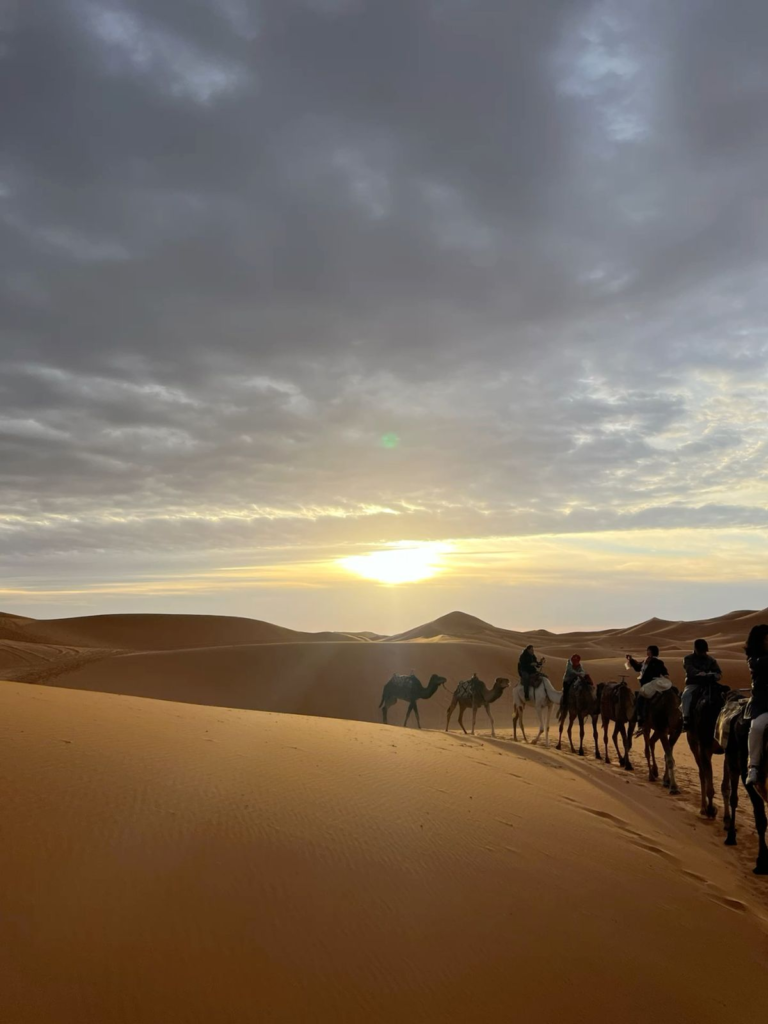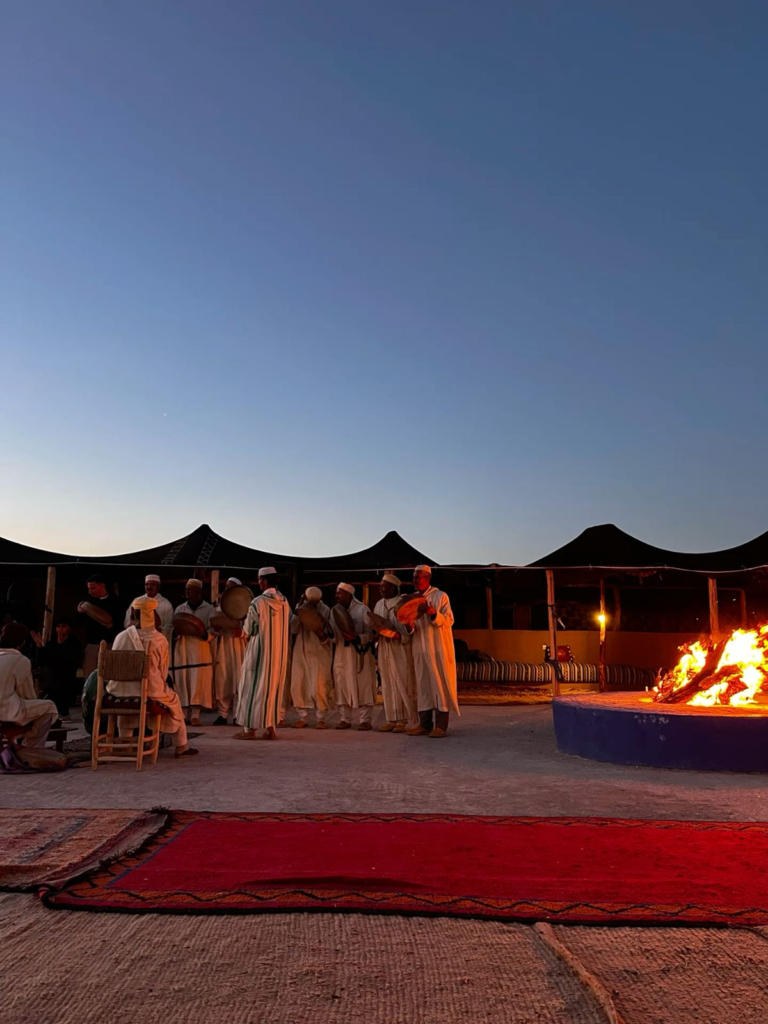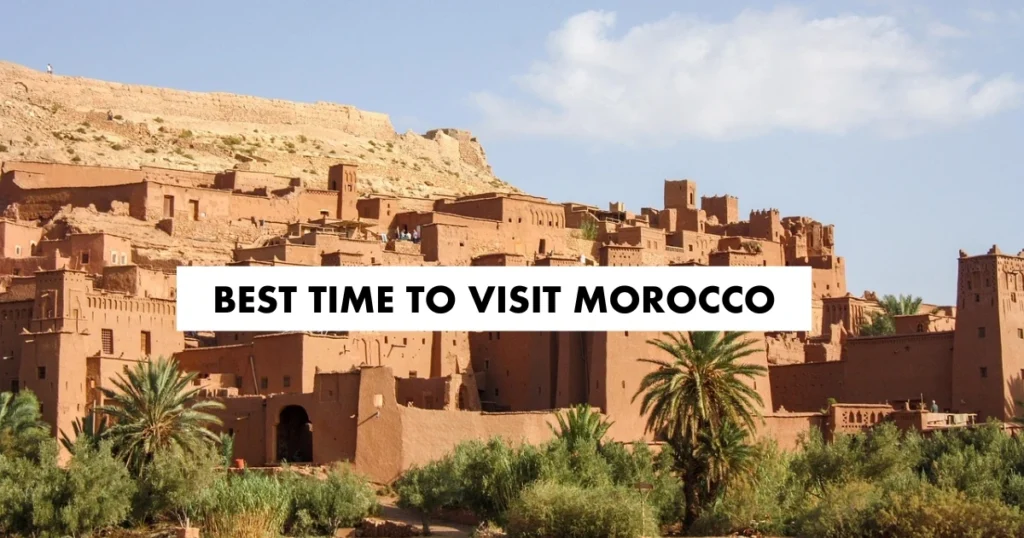Table of Contents
Planning a trip to Morocco means looking at its varied landscapes. You’ll find snow-capped mountains, vast deserts, and cool coasts. Morocco’s weather changes a lot depending on where you are. This guide helps you pick the best time for your trip, considering the weather, events, and what you want to see.
Whether you want to see spring flowers, enjoy desert adventures in summer, or experience fall festivals, Morocco has it all. You can avoid crowds, save money, and catch cultural celebrations at the right time.
Morocco’s different climates mean you can experience many seasons in one day. We’ll show you how to choose the perfect dates for your trip. This way, you’ll enjoy great weather and memorable cultural experiences.
Key Takeaways
- Morocco’s best time to go to morocco depends on your priorities: weather, festivals, or outdoor activities.
- Regions like Marrakech, the Sahara, and coastal cities like Essaouira each have unique seasonal conditions.
- Spring and fall offer comfortable temperatures for sightseeing in imperial cities like Fes and Meknes.
- Winter brings ski opportunities in the Atlas Mountains alongside vibrant local celebrations.
- Summer is ideal for desert trips but requires midday heat precautions.
Morocco’s Climate: A Seasonal Overview
Morocco’s climate changes a lot from the desert to the coast. Knowing the seasons helps plan your trip. Each season has its own weather, from green valleys to snowy mountains. Here’s how to plan your trip:
Spring (March-May): Mild Temperatures and Blooming Landscapes
Spring is great for outdoor fun. March gets warmer, and April is especially beautiful with flowers everywhere. By May, it gets hotter during the day but cools down at night.
This is the best time to visit Marrakech’s markets without the crowds of summer.
Summer (June-August): Desert Heat and Coastal Breezes

Summer is hot in cities like Fez and Meknes, with temperatures over 100°F. The desert is even hotter, but Tangier and Essaouira offer cool ocean breezes. Evenings are perfect for eating by the sea.
Fall (September-November): Perfect Weather for Exploring
Fall is the best time for exploring. September is sunny but not too hot, great for hiking. October is perfect for photos, with beautiful light and fewer tourists. November gets cooler, so pack warm clothes for mountain trips.
Winter (December-February): Diverse Climate Experiences
December in Morocco is different. The mountains are snowy, and Oukaimeden ski resort opens. But coastal towns stay mild. Cities like Rabat are less crowded, making it cheaper, except during holidays.
Best Time to Visit Morocco Based on Your Travel Goals
Planning your trip around your priorities unlocks Morocco’s full potential. Let’s break down peak moments for every interest:
best time to visit morocco
- Desert Adventures: Aim for spring (March-May) or fall (Sept-Nov) when Sahara temperatures are mild. Nighttime stargazing and camel treks stay comfortable, avoiding summer’s extreme heat.
- City Exploration: Marrakech in January offers cooler medina walks and lower hotel rates after holiday crowds fade. Fez and Casablanca shine in fall, but Morocco in winter also delivers quiet streets and festival-free deals.
- Coastal Relaxation: July-September brings sunny days to Essaouira or Agadir. The Atlantic breeze cools while inland cities swelter.
- Mountain Trekking: April-May and Sept-Oct reveal the Atlas Mountains at their best. Hike to Toubkal or explore Berber villages in crisp, dry conditions.
- Photography: Fall’s soft light turns Marrakech’s jamebs and desert dunes into golden backdrops. Sunrise at Ait Benhaddou or sunset in Chefchaouen are must-capture moments.
- Budget Travel: Save money in winter (Dec-Feb) and early spring. Flights and riad bookings drop post-holidays, with winter festivals like the Marrakech International Film Festival adding cultural flair.
| Goal | Best Months | Highlights |
|---|---|---|
| Desert trips | March-May, Sept-Nov | Night camps, clear skies |
| City tours | Jan-Feb, Sept-Nov | Quiet medinas, lower prices |
| Coastal stays | June-Aug | Beachside dining, surf lessons |
| Mountain hikes | April-May, Sept-Oct | Wildflower trails, village visits |
| Budget travel | Dec-Feb | Discounted rates, winter events |
Align your itinerary with these tips to match Morocco’s seasons with your perfect adventure.
Must-Experience Moroccan Festivals and Events Throughout the Year
best time to visit morocco

Plan your trip around Morocco’s vibrant festivals, where culture and climate intertwine. In January, the temperature in Morocco in January ranges from 45–65°F (7–18°C). This makes it perfect for winter celebrations like Yennayer, the Berber New Year.
Winter Celebrations: From New Year to Almond Blossoms
Embrace the climate morocco january during these events:
| Event | Date | Location | Highlights |
|---|---|---|---|
| Yennayer | January 12 | Nationwide | Traditional dishes like berber bread and storytelling sessions. |
| Almond Blossom Festival | January–February | Tafraoute | Breathtaking blooms with mild daytime temperatures. |
Spring Festivals: Music and Cultural Celebrations
- Fez Sacred Music Festival: April, featuring Sufi music and poetry.
- Gnaoua World Music Festival: June in Essaouira, mixing traditional and modern rhythms.
Summer Events: Beach Festivals and Moussems
Avoid midday heat and join coastal fun:
- Timitar Festival (July, Agadir): Amazigh music under starry skies.
- Moussems: Village festivals honoring saints, with local crafts and dances.
Fall Gatherings: Harvest Celebrations and Arts
As autumn cools the air, don’t miss:
- Marrakech Film Festival (October): Stars and indie films in a historic setting.
- Atlas Harvest Festivals: Villages celebrate olives and argan oil with tastings.
Book accommodations early for popular events. Check festival websites for ticket details and cultural etiquette guides. Layer clothing for climate morocco january conditions and respect local customs at sacred events.
Conclusion: The Ultimate Guide to the Best Time to Visit Morocco
best time to go to Morocco
Deciding on the best time to visit Morocco is essential for making the most of your journey. This diverse country offers a range of experiences, each influenced by its changing seasons. Whether you’re exploring the bustling souks of Marrakech, hiking through the majestic Atlas Mountains, or venturing into the golden dunes of the Sahara, choosing the right time of year will enhance your adventure.
For travelers seeking pleasant weather and fewer crowds, the best time to visit Morocco is during the spring (March–May) and autumn (September–November). These months bring mild temperatures, making outdoor activities like hiking, sightseeing, and desert tours enjoyable. Spring fills the valleys with blooming wildflowers, while autumn provides the perfect climate for cultural exploration.
If you’re dreaming of a coastal escape, summer (June–August) is ideal for visiting places like Essaouira and Agadir, where the Atlantic breeze offers a refreshing break from the heat. However, inland cities such as Marrakech and Fes can be extremely hot during this season. On the other hand, winter (December–February) is a fantastic time to see Morocco in a different light—quieter streets, lower prices, and even snow-covered peaks in the High Atlas Mountains.
Beyond the weather, cultural events play a big role in determining the best time to visit Morocco. Festivals like the Gnaoua World Music Festival in Essaouira and the Almond Blossom Festival in Tafraoute provide unforgettable experiences. If you visit during Ramadan, you’ll witness Morocco’s rich spiritual traditions, though some businesses may operate on reduced hours.
Planning ahead is crucial, especially if you’re traveling during peak tourist seasons. Booking accommodations and transportation in advance ensures a smooth trip, and packing appropriately for the season will keep you comfortable. Whether you prefer bustling city life, serene nature, or immersive cultural experiences, the best time to go to Morocco depends on your personal travel style.
No matter when you choose to explore Morocco, its beauty, history, and warm hospitality will leave a lasting impression. Every season unveils a new side of this enchanting country, making any time of the year a great opportunity to embark on a Moroccan adventure. So plan wisely, embrace the magic, and discover why travelers around the world consider Morocco a must-visit destination.
FAQ
What is the best time to go to Morocco?
The best time to go to Morocco varies based on your interests and where you want to go. Spring (March-May) and fall (September-November) are great for city tours and outdoor fun. Summer (June-August) is very hot in the interior, while winter (December-February) offers skiing in the Atlas Mountains and mild coastal weather.
What is the weather in Morocco in October?
October brings cooler weather, especially in cities and mountains. Expect temperatures from 70°F to 80°F (21°C to 27°C) in places like Marrakech. It’s perfect for sightseeing and outdoor activities.
How is Morocco in December?
Morocco in December is mild, with temperatures between 45°F to 65°F (7°C to 18°C) in most areas. It’s a good time for fewer crowds and lower prices. However, nights can be cold, especially in the desert and mountains.
What is the temperature in Morocco in January?
January temperatures vary by region. Coastal areas are mild, with highs around 60°F (15°C), but nights can drop significantly. The mountains may see snow and freezing lows. It’s great for winter sports in the Atlas Mountains.
What is the weather in Morocco in December?
December weather in Morocco is cool to mild, with highs from 50°F to 70°F (10°C to 21°C) depending on the area. Expect cooler evenings, especially in the desert.
What is the climate like in Morocco in January?
January’s climate varies by area; coastal spots have mild weather, while the Atlas Mountains may see snow. It’s a good month for city tours and cultural events with fewer tourists.
What is it like in Morocco during the winter?
Winter in Morocco (December-February) offers a mix of climates. Enjoy mild coastal weather, explore cities with fewer people, and try winter sports in the Atlas Mountains. This season also features unique cultural events, like Yennayer, the Berber New Year.
What is Marrakech like in January?
Marrakech in January is cooler, with temperatures between 45°F and 65°F (7°C to 18°C). It’s a great time for sightseeing without the summer heat and crowds, and you’ll find lower accommodation prices.
What is the weather in Morocco in April?
April in Morocco is warm and the best time to visit morocco, with temperatures from 65°F to 75°F (18°C to 24°C). It’s a beautiful time for urban exploration and enjoying landscapes with blooming wildflowers.

